
All-American Comics is a comics anthology and the flagship title of comic book publisher All-American Publications, one of the forerunners of DC Comics. It ran for 102 issues from 1939 to 1948. Characters created for the title, including Green Lantern, the Atom, the Red Tornado, Doctor Mid-Nite, and Sargon the Sorcerer, later became mainstays of the DC Comics line.
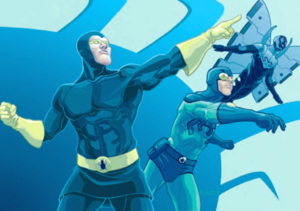
Blue Beetle is the name of three superheroes appearing in a number of American comic books published by a variety of companies since 1939. The most recent of the companies to own rights to Blue Beetle is DC Comics, which bought the rights to the character in 1983, using the name for three distinct characters over the years.
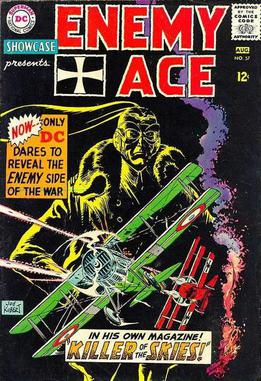
Enemy Ace is a DC Comics property about the adventures of a skilled but troubled German anti-hero and flying ace in World War I and World War II, Hans von Hammer, known to the world as "The Hammer of Hell". Debuting in 1965, the comic was written by Robert Kanigher and drawn by Joe Kubert and the character has been revived several times since by other writers and artists.
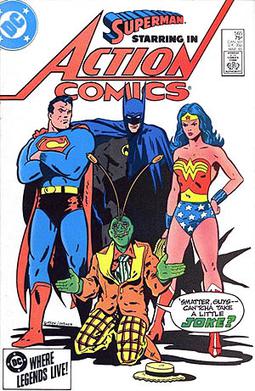
Ambush Bug is a superhero appearing in American comic books published by DC Comics. His real name is supposedly Irwin Schwab, but he has mental problems that prevent him from truly understanding reality around him, so even his true identity might be no more than a delusion on his part. His origin is disputed, although the most commonly accepted origin is that Brum-El of the planet Schwab sent his clothes from his supposedly doomed planet, hoping that his wardrobe would survive, only to have it intercepted by a giant radioactive space spider. In the resulting crash, only two articles of clothing survived: the Ambush Bug suit, which was subsequently found by Irwin Schwab; and "Argh!Yle!", an argyle sock with a Doctor Doom-like complex, complete with metal mask.

The Inferior Five are a parody superhero team appearing in books by the American publisher DC Comics. Created by writer E. Nelson Bridwell and artist Joe Orlando, the team premiered in the DC Comics title Showcase #62.

Samuel Emerson "Slam" Bradley is a fictional character that has appeared in various comic book series published by DC Comics. He is a private detective who exists in DC's main shared universe. The character concept was created by DC Comics founder Malcolm Wheeler-Nicholson and developed by Jerry Siegel and Joe Shuster, who both later became more well known as the co-creators of Superman. As one of the first ever DC characters, the character first appears in the Golden Age of Comic Books in the anthology title Detective Comics, being introduced in the first issue. He later commonly was associated with Batman and other spinoff Batman characters when revived.

Uncle Sam is a superhero appearing in American comic books published by DC Comics. Based on the national personification of the United States, Uncle Sam, the character first appeared in National Comics #1 and was created by Will Eisner.

Sugar and Spike is an American comic book series published by DC Comics from 1956 through 1971, named after its main protagonists. The series was created, written, and drawn by Sheldon Mayer.
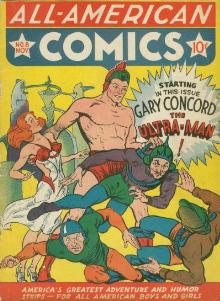
Ultra-Man is the name of two fictional comic-book superheroes, father and son, that first appeared during the 1940s, the period fans and historians call the Golden Age of comic books. Both were characters of All-American Publications, which merged, in 1946, with DC Comics-predecessor National Periodical Publications.

Anthro is a fictional superhero character published by DC Comics, presented as the "first boy", a caveman born to Neanderthal parents. Anthro was created by cartoonist Howard Post; he first appeared in Showcase #74.

Ultra the Multi-Alien is a science fiction superhero featured in comics published by DC Comics. He first appeared in Mystery in Space #103 (1965), pushing out Adam Strange and Space Ranger from that title. He was created by writer Dave Wood and artist Lee Elias.
Space Cabbie is a science fiction character in DC Comics.
The Viking Prince is a fictional Viking hero appearing in comic books published by DC Comics. The character first appeared in The Brave and the Bold #1, and was created by Robert Kanigher and drawn by Joe Kubert. He was one of three historical fiction characters to premiere in the first issue.
George Edward Papp was an American comics artist best known as one of the principal artists on the long-running Superboy feature for DC Comics. Papp also co-created the Green Arrow character with Mort Weisinger and co-created Congo Bill with writer Whitney Ellsworth.
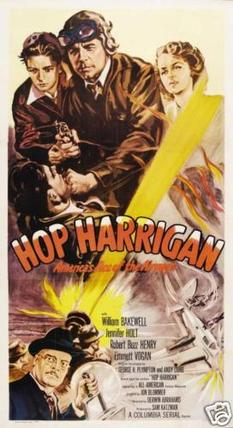
Hop Harrigan (1946) is a Columbia film serial, based on the Hop Harrigan comic books by DC Comics. The serial comprised 15 two-reel chapters with Derwin Abrahams as the director, and Sam Katzman, the producer. Columbia Pictures was one of the last Hollywood studios to continue in postwar years with the serial format. By 1947, Universal Pictures discontinued their serials, with only Republic Pictures and Columbia continuing with serials. The last serial was Columbia's Blazing the Overland Trail (1956).
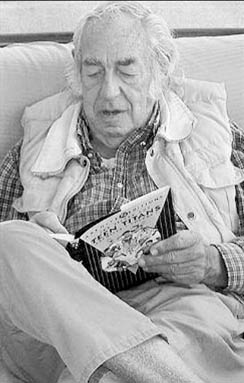
Robert Gilbert Haney, Jr. was an American comic book writer, best known for his work for DC Comics. He co-created the Teen Titans as well as characters such as Lance Bruner, Metamorpho, Eclipso, Cain, and the Super-Sons.
Francis Edward Herron was an American comic book writer and editor active in the 1940s–1960s, mainly for DC Comics. He is credited with co-creating Captain Marvel Jr. and the Red Skull, as well as such characters as Cave Carson, Nighthawk, and Mr. Scarlet and Pinky the Whiz Kid. Herron spent the bulk of his time in the comics industry writing for such characters as Green Arrow, Superman, and the Western character Tomahawk.
Jack Schiff was an American comic book writer and editor best known for his work editing various Batman comic book series for DC Comics from 1942 to 1964. He was the co-creator of Starman, Tommy Tomorrow, and the Wyoming Kid.
National Comics Publications and All-American Publications, two precursors to DC Comics, were formed publishing American comic books such as superhero comics starting in the 1930s. Primary Comic book anthology titles created by the company was More Fun Comics, Adventure Comics, Detective Comics, Action Comics, All-American Comics and Superman. Other companies like Quality Comics and Fawcett Comics would later be merged into DC. Quality started by introducing comic books like Feature Comics and Smash Comics.
Red Tornado is a codename for different characters appearing in American comic books published by DC Comics that appear in the mainstream and other realities. The most common of them is Ma Hunkel and the android version.












